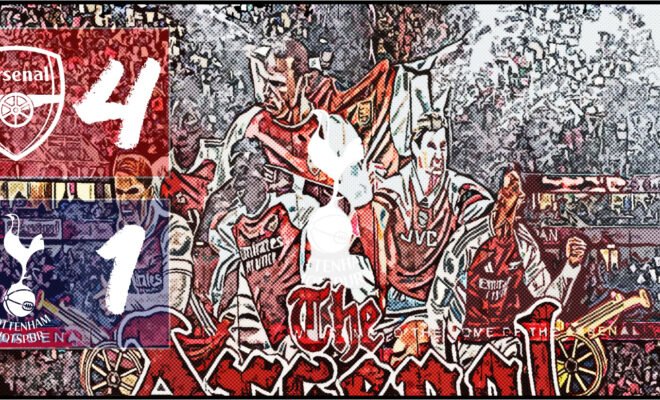Arsenal Crush Spurs 4–1 in North London Derby as Eze Shines

Arsenal didn’t just win a derby. They produced the kind of controlled, confident performance that signals a team with serious ambitions at the top of the Premier League. The context mattered. Liverpool dropped points. Manchester City lost. For a club that has been building toward a title challenge for years, this was the moment to take advantage. And Arsenal did exactly that.
The Emirates felt charged before kickoff, and the players responded with a display that combined patience, structure, and clinical execution. Despite missing several key starters, Arsenal controlled every major phase of the match. The patterns were coherent, the pressing was measured, and the attacking sequences carried purpose from start to finish.
This wasn’t a chaotic derby defined by emotion. It was a systematic dismantling shaped by clarity, structure and the confidence of a team that now understands how to impose itself.
Here are the three key things we learned from Arsenal’s 4–1 win.
Arsenal solved a deep defensive block through structure and repeatable patterns
From the opening minutes it was clear Tottenham wanted to slow the match, defend deep, and hope to frustrate Arsenal long enough to create doubt. For years, this type of setup caused Arsenal problems. Not today. Arsenal approached it with patience and intent, using well-rehearsed spacing and coordinated movements to create openings in the central areas Spurs worked hardest to protect.
The match played out with Arsenal owning the left inside channel. Mikel Merino’s role was central to that. Even though he started as the striker, he constantly dropped into midfield to create overloads. His positioning forced defenders to step out, and the moment they did, Arsenal had openings behind the line.
The breakthrough goal was the best example. Merino received in space, lifted his head, and played an excellent lofted pass through the gap for Trossard. The run was timed perfectly. The touch was sharp. The finish was clean. But none of that happens without the coordinated structure that created the window in the first place.
This pattern repeated throughout the match. Arsenal didn’t just circulate the ball around the block; they kept playing into the exact pockets that generated danger. The passing maps and pitch control charts from your data showed a heavy concentration just outside the penalty area, exactly where Arsenal wanted the match to be played.
And this is where Eze thrived.
His first goal came from Rice identifying the central seam, playing the ball into Eze in that familiar pocket. His second came from Timber exploiting the same zone, driving forward and laying the ball off into space. His third arrived from a Trossard cutback, again arriving in the same corridor between the penalty spot and the D.
These were not improvisational moments. They were the product of repeatable, coached sequences that Arsenal ran again and again until space finally broke.
The deeper lesson is significant: Arsenal now have the tools to break down compact blocks without needing a traditional No. 9 on the pitch. The collective structure carried the load.
Eze, Trossard, and Arsenal’s reshaped defense showcased elite depth
For Arsenal supporters, the most encouraging takeaway from the match was not just the goals — it was how the squad handled major absences. Without Gabriel, Ødegaard, Havertz, and Gyökeres, Arsenal should have been stretched. Instead, the replacements elevated the performance.
Eberechi Eze delivered his standout moment in an Arsenal shirt.
His three goals were the headline, but the full performance was even better. He finished with:
-
Six shots
-
Three goals
-
Seven touches in the box
-
Multiple progressive carries
-
Constant presence in the exact areas Arsenal wanted to attack
The shot maps from your visuals show every attempt coming from high-value central positions. He didn’t drift wide. He didn’t settle for speculative efforts. He occupied the spaces Tottenham couldn’t track and punished them every time the ball arrived.
This was the performance of a player who understands the system and knows where the opportunities will emerge.
Leandro Trossard delivered the most complete performance on the pitch outside of Eze.
He worked tirelessly between lines, held up the ball in tight spaces, and provided connection whenever Arsenal needed to reset or re-accelerate. His goal was a reward. His assist for Eze’s final strike came from intelligent movement and precise timing.
Trossard’s contribution was both technical and tactical. He provided:
-
Six progressive passes
-
Multiple box entries
-
Fluid link play in the left channel
-
Reliable retention under pressure
His influence allowed Arsenal to maintain a strong grip on the match’s rhythm.
Then there was the defensive reshuffle.
This was where Arsenal supporters could take the greatest comfort, because losing Gabriel in a derby is the kind of absence that normally causes structural stress. Instead, Arsenal looked stable from the first minute.
Piero Hincapié delivered an assured league debut. He was aggressive stepping out, composed on the ball, and strong in duels. His progressive passing and defensive interventions were crucial in pinning Tottenham back in their half.
Riccardo Calafiori was equally reliable on the opposite side, reading danger early, managing transitions, and helping maintain compact spacing across the back line.
Jurrien Timber added the intelligence and calm that has been missing since his injury last season. His involvement in the second goal highlighted his comfort stepping into midfield and creating overloads.
The important thing:
Arsenal played a derby without their first-choice center-back pairing, without their captain, without their new striker, and still produced a 4–1 result with complete control.
That is not normal. That is the sign of a deep, well-coached team.
The bigger picture: Arsenal looked like a team ready for the long haul
The broader context matters as much as the match itself. With this win, Arsenal sit six points clear after 12 games, a lead no Premier League team has ever failed to convert into a title. That statistic doesn’t hand Arsenal anything, but it reflects the rarity of the position.
What matters more is how Arsenal achieved it.
This was not a chaotic 4–1. It was methodical. It was repeatable. It matched the profile of a top team controlling a match from beginning to end, using its structure to generate high-value sequences and prevent risk.
The data from your visuals supported that:
-
Arsenal dominated field tilt, spending long stretches in the attacking third.
-
Pitch control maps showed Arsenal suffocating central spaces where the match could change.
-
The GPA (Goal Probability Added) charts heavily favored Arsenal from the opening whistle.
-
Passing networks revealed balanced distribution, with clear lanes through Rice, Merino, and Eze.
-
Deep touch maps highlighted Arsenal’s sustained presence near the six-yard area.
Nothing about the performance relied on luck or a single player carrying the match. The structure produced the chances. The squad depth converted them.
And this is the key difference from past seasons.
This Arsenal doesn’t break when starters are missing.
This Arsenal doesn’t need perfect conditions to dominate.
This Arsenal doesn’t rely on one source of goals or one method of chance creation.
That consistency shows up in the numbers, the eye test, and the way the team manages tempo. The team looks more mature in possession, more coordinated off the ball, and more confident in tight spaces.
If you follow this club closely, this is the kind of match that gives you clarity about the bigger picture. Arsenal didn’t just win a derby; they played like a side built for a title run.
Conclusion
Arsenal’s 4–1 win over Tottenham delivered more than goals and bragging rights. It revealed a team with tactical clarity, structural maturity, and squad depth strong enough to handle any stretch of the season. Every major moment pointed in the same direction: Arsenal are evolving into a side with repeatable solutions in possession, reliable defensive mechanisms, and attacking players who understand exactly where the danger zones are.
Eze’s hat-trick will be remembered for years. But the significance of this performance was the collective control, the coherence in the patterns, and the way the squad delivered despite missing multiple starters.
This is what a top team looks like — not just in moments, but across full matches, across different types of challenges, and across the season’s key turning points.
Arsenal took advantage of a major opportunity in the title race, and they did it playing their football. The confidence, the structure, and the depth all point toward a team that is ready for the long run ahead.
Leave a reply
You must be logged in to post a comment.


